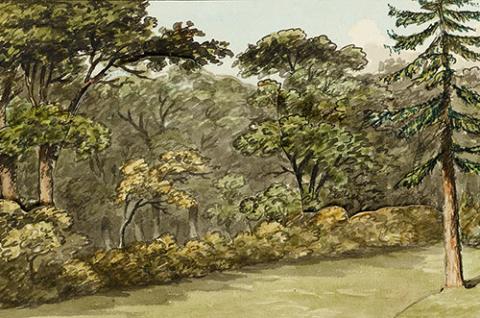
Repton prepared this Red Book for Samuel Phipps of Lincoln's Inn, a prosperous attorney, who had purchased the Ferney Hall estate around 1787. Called to the bar in 1763, Phipps amassed a fortune in the service of "grand families," nabobs, and political luminaries, such as the third duke of Portland (one of Repton's first and most important patrons). He also owned the estate of Barmoor Castle in Northumberland. After taking possession of Ferney Hall, he hired a local landscaper to lay out the grounds, but, dissatisfied with the results or dissuaded by his friends, he invited Repton to inspect his property over the course of three days in September 1789.
This commission came just at the beginning of Repton's career, when he was still developing the format of his Red Books. In this one, he did his best to impress his client with his practical expertise, Picturesque sensibilities, and cultivated taste. Unlike the local nurseryman, Repton could deal with Phipps as an equal, if not in social status then as an educated gentleman, fully capable of describing the delights of a rocky ravine by quoting Spenser and Ovid. Phipps appears to have been pleased by Repton's advice, but he died in 1791, before he could act on it.
Phipps was not the only one to take a personal interest in this Red Book, which became "Exhibit A" in the Picturesque debate. Not far from Ferney Hall resided Richard Payne Knight, a member of Parliament, collector of antiquities, and author of several books on art and aesthetics. Knight had designed his own landscape garden in accordance with Picturesque principles. In due deference, Repton consulted with this distinguished neighbor, who initially "dreaded the approach of a professed improver" but discovered that Repton was "a man of liberal education" and that they agreed in many matters of style. No doubt Knight approved of the plan to demolish the formal terrace and restore the original view of pastoral scenery outside the windows of the front rooms. He might have liked the idea of pruning the trees outside the drawing room window to give a glimpse of a distant pool. He claimed to have had "pleasing expectations" about Repton's work—but the plans he saw "instantly undeceived me."
Did Phipps show the Red Book to Knight? If so, it failed to please this arbiter of taste, who could have been a valuable ally but turned out to be a formidable opponent. He apparently took exception to certain economizing measures and attempts to preserve a few of the formal amenities in the grounds, which Repton wanted to give an "appearance of dress." The proposal to ornament the Common with clumps of trees might have smacked of "Brownism" in Knight's opinion. In 1794 he launched the first salvo of the Picturesque controversy with the publication of The Landscape: A Didactic Poem, a satiric attack on the garden designs of Brown and Repton. Caught off guard, Repton had been expecting to publish his Sketches and Hints on Landscape Gardening in 1794, but he held it back until the following year so that he could include supplementary remarks responding to his critics. Knight fired back with a second edition of The Landscape, containing a critique of the plans for Ferney Hall, now condemned in every respect except for a proposal to preserve a venerable orchard, "which would have pleased a landscape painter." More's the pity, said Knight, since this was the only proposal to have been rejected by his neighbor, a knowledgeable and cultivated person but utterly in thrall to conventional ideas of garden design. Knight could not have described the plans and Phipps's reaction to them in such convincing detail unless he had seen the Red Book, a provocative document, which all too eloquently outlined the grounds for debate.
Situated in Shropshire, five miles from Ludlow, the Ferney Hall estate at one point extended over eight hundred acres. Now the property has dwindled to ten acres consisting of some lawns, a pool, an orchard, a walled garden, and a woodland walk. Repton would not have approved of the present red brick Victorian mansion, largely restored but at such a cost that it was put up for sale in June 2009.
Humphry Repton
1752-1818
The Red Book of Ferney Hall
[1789]
Pen and brown ink and watercolor on paper
Binding: 8 1/2 x 11 1/2 inches (216 x 292 mm)
Gift of Mr. Junius S. Morgan and Mr. Henry S. Morgan
1954.17
See more information »
